For the ultimate in traditional Japanese experiences a visit to Kyoto is a must. Immerse yourself in the best of Kyoto with our handy guide.
Travel to Japan: best things to see, do and experience
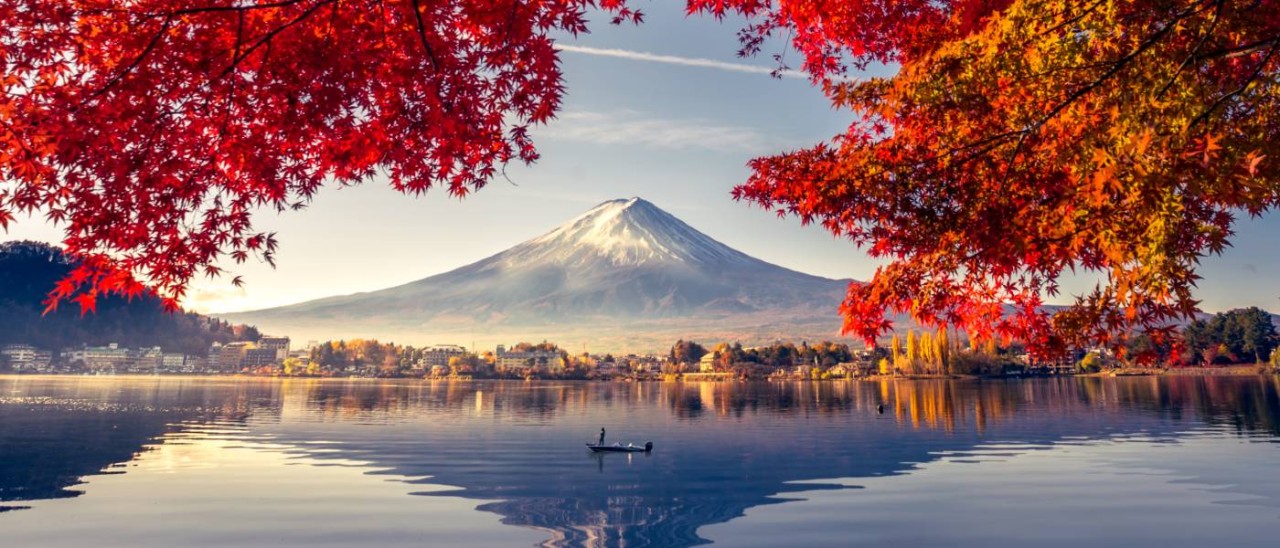
From the quiet beauty of cherry blossoms and hot springs to the lively energy of sumo tournaments and anime culture, Japan offers experiences for every type of visitor.
Japan is a destination like no other. It's a country where centuries-old traditions blend seamlessly with cutting-edge technology, where serene temples sit side by side with neon-lit skyscrapers, and where the food, culture and hospitality leave a lasting impression on every traveller.
This comprehensive guide explores the very best things to see and do in Japan. Whether you're a first-time visitor or returning for a deeper dive, this guide will help you make the most of your journey through the Land of the Rising Sun.
RACV Travel & Experiences is your one-stop shop for travel, with RACV Members saving on tours, cruises holiday packages, travel insurance and more.
Jump to
 Why visit Japan?
Why visit Japan?
Japan's ancient history and modern innovations
Japan’s appeal lies in its ability to embrace the future without losing touch with its past. In Kyoto, tea ceremonies and geisha performances preserve centuries-old customs. Meanwhile, Tokyo dazzles with skyscrapers, robot restaurants and high-tech transport. This mix of history and progress makes Japan unique among travel destinations.
Japan's stunning four seasons
Japan is truly a year-round destination. Spring brings cherry blossoms, summer offers colourful festivals and fireworks, autumn dazzles with fiery foliage, and winter transforms Hokkaido and the Japanese Alps into ski paradises. Each season has its own character, making repeat visits worthwhile.
Safe, clean and easy to explore
Japan is consistently ranked one of the safest countries in the world. Public transport is reliable, streets are spotless and hospitality is warm. This makes it an ideal choice for families, solo travellers and first-time visitors to Asia.
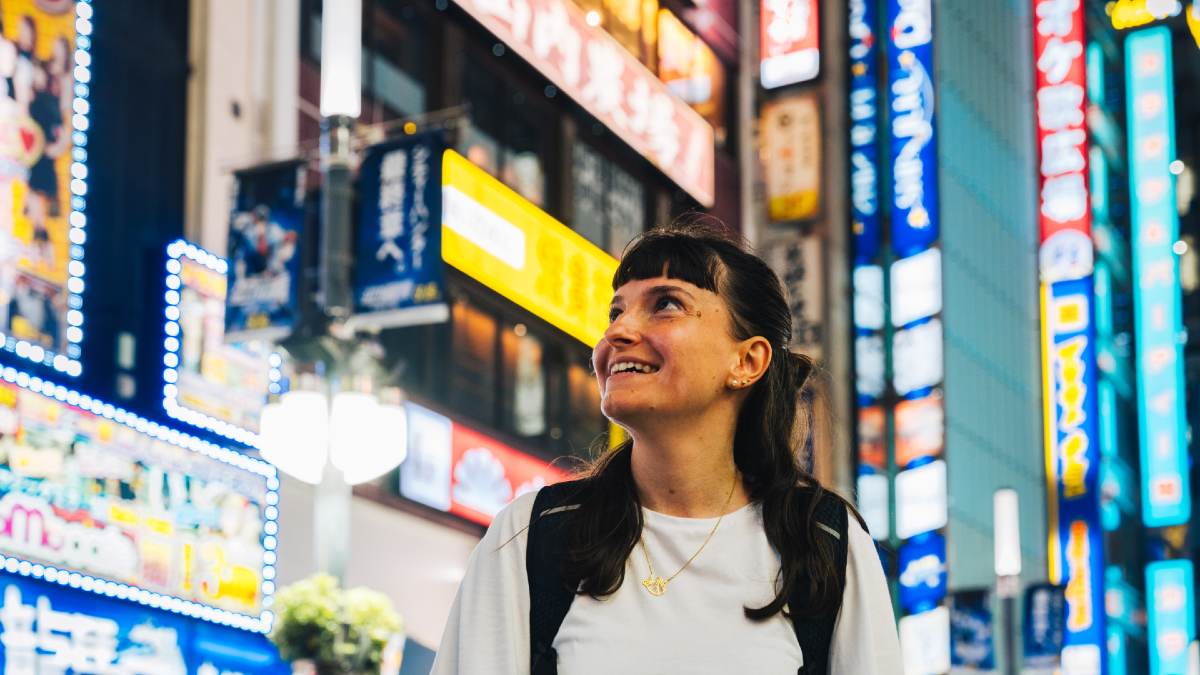
Japan offers a mix of tradition and modernity. Image: Getty
Samurai experiences and locations in Japan
The samurai were Japan's elite warrior class. For 700 years, from the Kamakura to Edo periods, samurai shaped Japan's politics, culture and philosophy. Japan's samurai defended her from Mongol invasions, Portuguese armadas and internal rebellions. They were fiercely loyal to their daimyo (feudal lords), often fighting in clan rivalries, and followed a strict code of honour called bushidō.
Where to experience samurai culture in Japan:
- Samurai Museum, Tokyo - a compact but fascinating museum in Tokyo's Shinjuku district, with armour, kabuto (helmets), swords and teppo (firearms) on display.
- Samurai Ninja Museum, Kyoto - step into history at this interactive museum, where you can don samurai armour and practice your swordsmanship, or opt for a guided tour of the samurai swords, armour and artefacts on display.
- Yonezawa Uesugi Festival, Yamagata Prefecture - every year on 3 May, participants relive the historic Battle of Kawanakajima between the Uesugi and Takeda clans. You can even participate yourself for a fee, which includes a rental armour costume! Arrive from 29 April to see parades and other festivities.
- Nagamachi Samurai District, Kanazawa - explore preserved bukeyashiki: traditional samurai residences from the Edo period, like the Nomura Samurai House. While in the area, visit the Maeda Tosanokamike Shiryokan to see local samurai armour and relics.
- Nikko Toshogu Shrine, Tochigi Prefecture - the beautiful mausoleum of famous samurai Tokugawa Ieyasu, founder of the powerful Tokugawa Shogunate. On 16-17 October each year, armoured 'samurai' parade along the streets to recreate Ieyasu's body arriving at the shrine.
- Shoshazan Engyoji Temple, Himeji - are you a fan of the Hollywood film The Last Samurai? The main character Nathan Algren formally meets the samurai leader Moritsugu Katsumoto here at this ancient temple in the film.
- Kiyosu Castle, Aichi Prefecture - Oda Nobunaga, the influential daimyo and warlord who unified Japan, used Kiyosu Castle as a base during his conquest. There are samurai armour and sword displays around the four-storey castle, plus film costumes that portrayed historical figures. Keep an eye out for the Kiyosu Castle Warrior Brigade! Make sure to visit nearby Tokugawa Art Museum, which hosts a wide collection of samurai art and artefacts.
- Shimabara Castle, Nagasaki Prefecture - this lovely white castle, ruled by the Matsudaira clan from the 1660s, is full of documents on samurai history. Its surrounding residential district Teppo-machi has three preserved samurai houses open to the public.
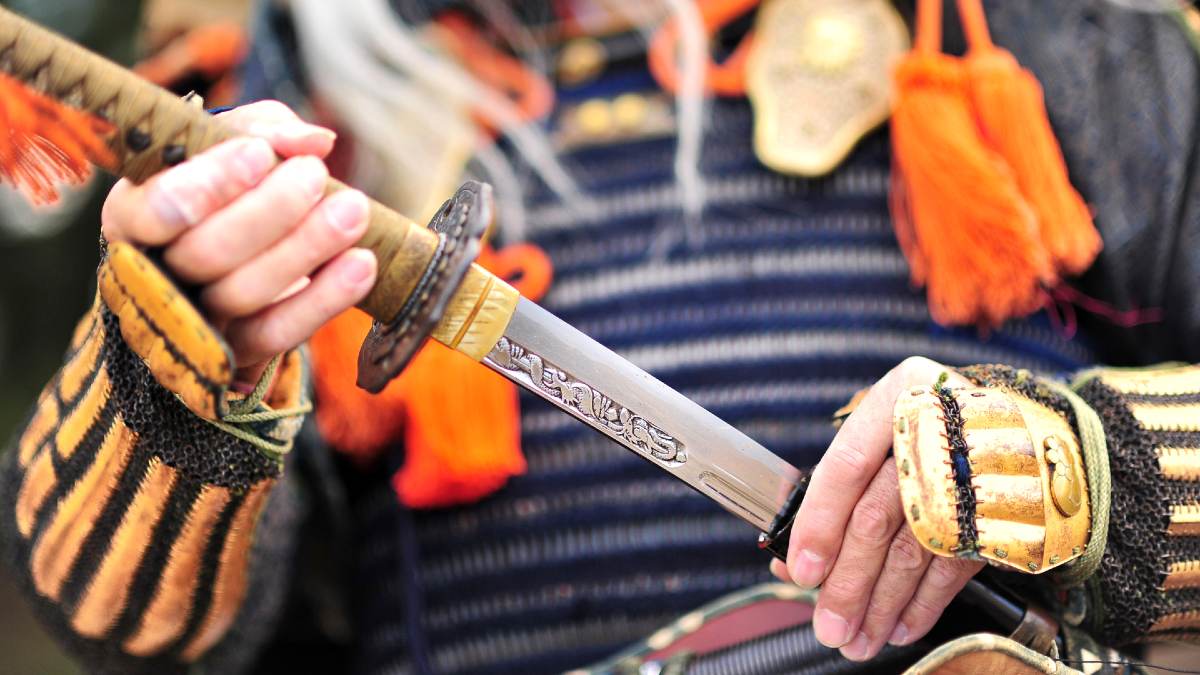
Many samurai swords, armour and artefacts can be seen in Japan. Image: Getty
Ninja villages, shows and training schools
Often romanticised in modern media, ninja (shinobi) were skilled covert agents in feudal Japan. They specialised in espionage, infiltration, sabotage and survival techniques, living outside the code of honour that bound samurai. Originally elite peasant-warriors from Iga Province and Koka District that formed ikki (leagues) for self-defence, they eventually sold their services as spies and mercenaries.
Top ninja experiences in Japan:
- Ninja Trick House, Tokyo - experience a hands-on ninja workshop in Tokyo's Shinjuku district, complete with sword demonstrations, shuriken throws and Nine Hand Seals meditations.
- Iga-ryu Ninja Museum, Mie Prefecture - many real ninja came from the Iga province. Daimyo at nearby Iga Ueno Castle employed the local ninja for covert missions. At the Iga-ryu Ninja Museum, watch ninjutsu demonstrations, learn at the onsite museum, and try your hand at the trick house full of trapdoors, hidden staircases and more.
- Togakure Ninja Museum, Nagano - explore a museum full of ninja weapons, clothing and gear. Next door, the 'ninja house' allows you sneak through a labyrinth of traps and secret passageways before practicing your shuriken throwing at a target range. Down the road, the Chibikko Kids Ninja Village lets kids don ninja outfits and roam a forest obstacle course and blowdart range.
- Koka Ninja Village, Shiga Prefecture - ninja used Koka's rugged terrain to practice guerilla fighting. The Koka Ninja House claims to be Japan's only remaining house where ninja actually lived and trained, and it's open to the public to explore. The nearby Koka Ninja Village has ninja-style throwing ranges and obstacle courses for guests.
- Myoryuji Temple (Ninja Temple), Kanazawa - a samurai lord's secret fortress, full of escape routes and deceptive defences like trapdoors, secret rooms and hidden tunnels. While it was never used by ninja, its design is very ninja-esque.
- Ninja Akasaka, Tokyo - this playful restaurant in Tokyo's Minato district has the waitstaff act like ninja, with guests escorted through secret doorways into the hidden dining room.
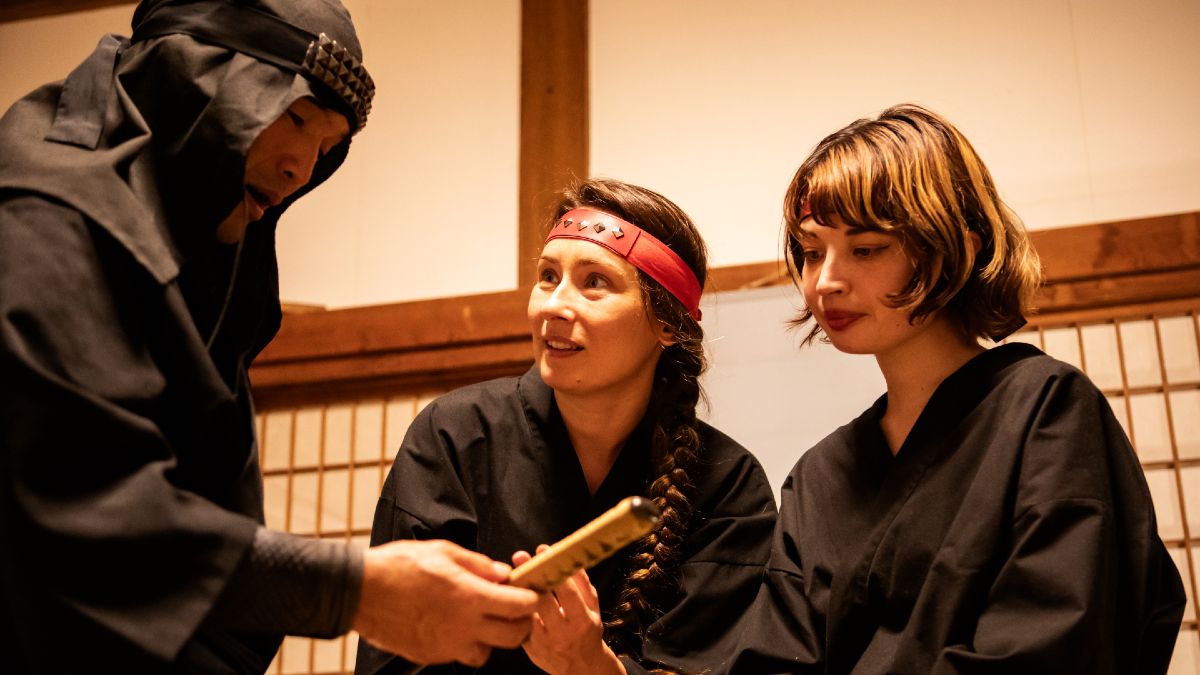
Shinobi were trained in espionage and sabotage. Image: Getty
Geisha performances in Japan
Geisha (often called geiko in Kyoto) are skilled entertainers who preserve Japanese traditional arts, from dance and shamisen music to tea ceremony and poetry.
By 1800, almost all geisha were female, wearing trailing kimono, traditional hairstyles and striking oshiroi makeup. They mostly performed for wealthy clientele at parties known as ozashiki, although you can now see them at cultural festivals too.
Please note that taking a picture of geisha without their permission is prohibited in Kyoto's geisha district and penalties may apply. In general, always ask before taking photos of people, no matter where you are.
Best places to experience geisha culture:
- Gion District, Kyoto - the most famous geisha district, with evening walks often offering glimpses of geiko and maiko (apprentice geisha).
- Gion Corner Theatre, Kyoto - watch geisha and maiko display the seven traditional performing arts on stage: chanoyu (preparing tea), koto music, ikebana flower arrangement, bugaku dance, kyogen comedy and kyomai dance.
- Higashi Chaya District, Kanazawa - historic townscape filled with wooden chaya (teahouses), inside of which geisha sing, dance and play traditional games.
- Asakusa Cultural Centre, Tokyo - geisha perform on Saturdays throughout the year in this more modern setting, showcasing a variety of cultural skills. It's a free performance, although capacity is limited so you'll need to pick up a ticket early.
- Gion Kagai Art Museum, Kyoto - exhibits feature precious items like hand-painted kimono, kanzashi hair ornaments, and personal belongings and makeup used by maiko. The museum also hosts kyomai dance performances from maiko and geiko.
- Somaro Maiko Teahouse, Sakata - on the second floor of this historic teahouse, you can watch daily maiko performances with dancing and shamisen (traditional string instrument) playing.
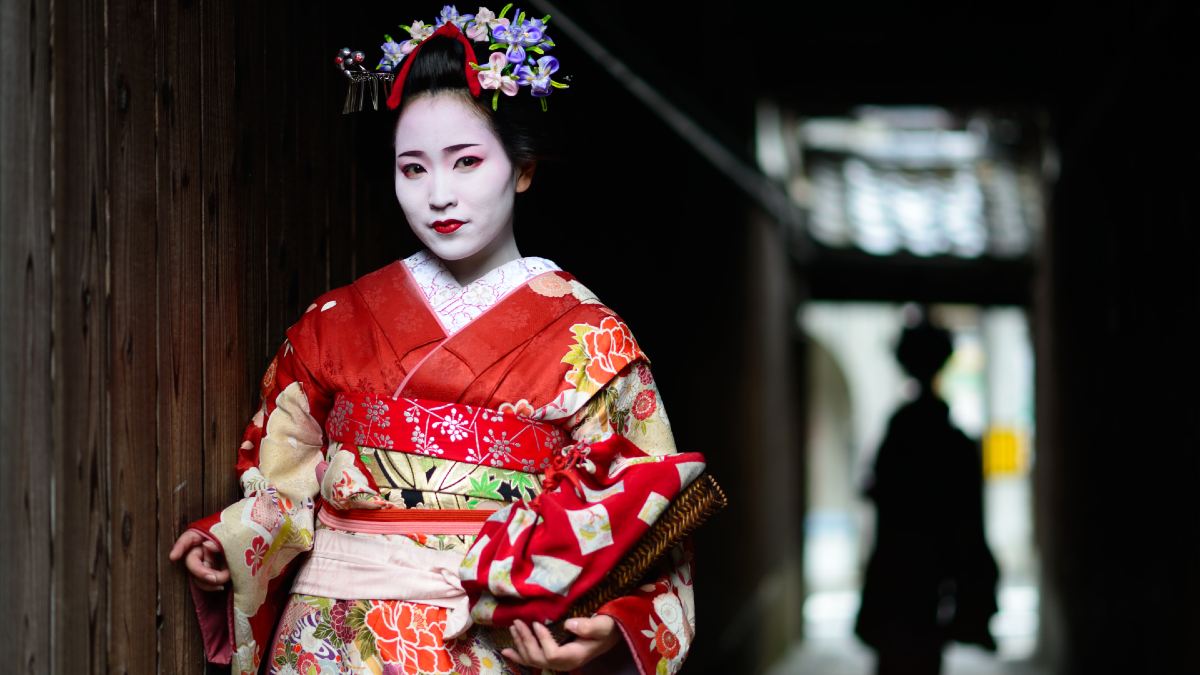
Maiko are geisha in training, especially in Kyoto. Image: Getty
Where to see sumo wrestling in Japan
Sumo is one of the oldest organised sports in the world and is considered the national sport of Japan. This wrestling competition involves rikishi (wrestlers) attempting to force his opponent out of the ring, or into touching the ground with anything other than the soles of his feet.
Sumo wrestlers are renowned for their large girth and body mass, which helps them resist being pushed during matches. They have highly regimented lives: they must live in communal sumo training stables (heya), where everything from their meals to their manner of dress is dictated by strict tradition.
The matches are likewise strictly regimented, with elaborate entering ceremonies, symbolic cleansing of the ring with salt, rinsing the mouth with chikara-mizu (power water) before a fight, and repeating a warm-up routine called shikiri. After all that, the matches usually only last a few seconds!
Where to see sumo in Japan:
- Ryogoku Kokugikan, Tokyo - Japan's main sumo stadium, hosting national sumo tournaments in January, May and September. Located in Tokyo's Sumida district, the Ryogoku neighbourhood is full of sumo stables and restaurants serving chanko nabe: a stew that's a fixed part of the sumo diet.
- Sumo Museum, Tokyo - located next to the stadium, this museum hosts exhibits on the sport's history and culture, with artefacts like kesho-mawashi (sumo wraps) and a shrine to the sumo god Nomi no Sukune.
- Edion Arena, Osaka - Japan's second grand sumo tournament of the year is held in Osaka in March, with six tournaments over 15 days.
- IG Arena, Nagoya - watch Japan's fourth annual sumo tournament in July. Wrestlers fight in a round-robin style organised by sumo guilds.
- Fukuoka Kokusai Centre, Fukuoka - hosts the sixth and final sumo tournament each year in November.
- Kehazaya Sumo Museum, Katsuragi - sumo museum with a demonstration sumo tournament ring that guests are free to step into and take photos.
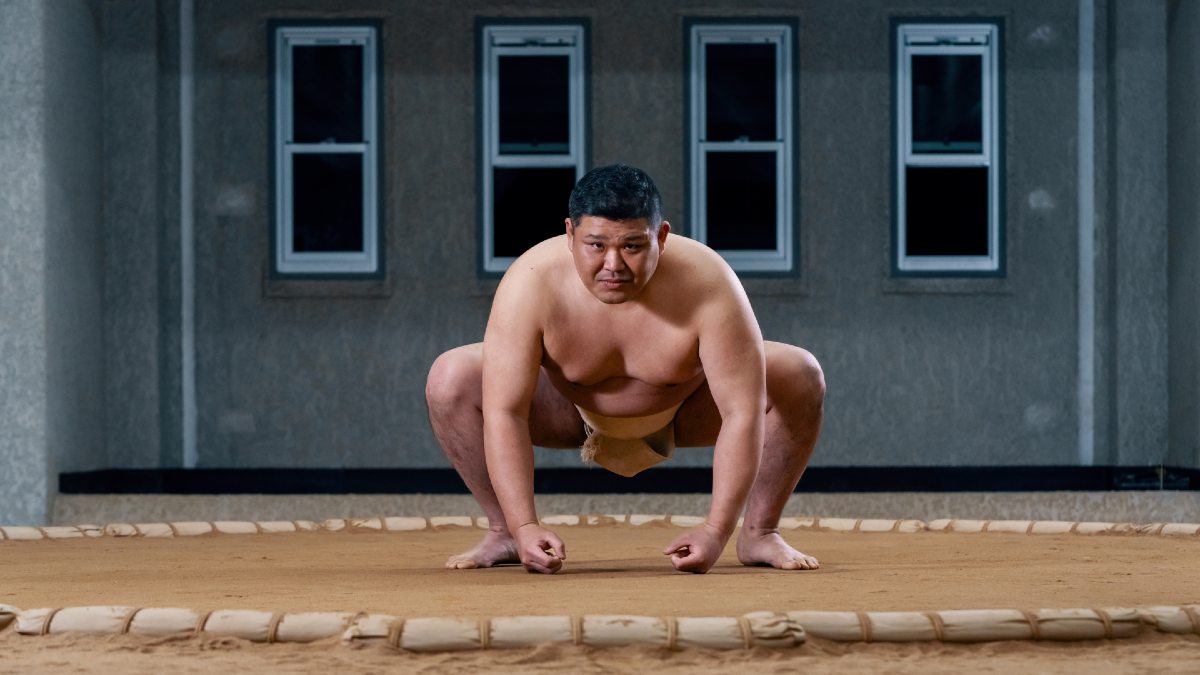
Sumo is an exciting sport to watch in Japan. Image: Getty
Famous Japanese Buddhist temples and Shinto shrines
Japan's two major religions are Shinto and Buddhism. Their shrines and temples are stunning and contemplative sites to visit in Japan, giving travellers a sense of the country's spiritual heritage.
You can recognise a Shinto temple by its traditional torii gate, often painted vermilion. Shinto is Japan's indigenous faith, which believes that kami (sacred spirits) are imbued in important locations and concepts: rain, mountains, fertility, and so on - and when a person dies, they become a kami too. Many Shinto rituals include prayers and purification to keep away evil spirits and make offerings to the kami. At Shinto shrines (jinja), wash your hands and mouth at the water basin before entering. Ring the bell and clap your hands to rouse the kami before praying.
Buddhism came to Japan from India via China and Korea in the sixth century. Despite some initial conflicts with Shinto, the two religions grew to co-exist and even complement each other. Buddhists venerate the concept of enlightenment, as taught by the Buddha. Some of the most popular Buddhist sects in Japan include the Shingon, Tendai, Jodo, Zen and Nichiren. At Buddhist temples (tera), pray silently or softly chant Buddhist mantras.
Top Japanese Shinto shrines:
- Fushimi Inari Shrine, Kyoto - this iconic Shinto shrine is famous thanks to its thousands of vermilion torii gates.
- Itsukushima Shrine, Miyajima - this UNESCO World Heritage site, along with its torii gate, seems to float on the sea at high tide.
- Naiku Shrine, Ise - enshrining Amaterasu Omikami (the Sun Goddess), Shinto's most venerated deity, this is widely considered Japan's most sacred shrine.
- Izumo Taisha, Shimane - often thought to be Japan's oldest shrine, visitors clap their hands four times instead of the usual twice during their prayers: twice for themselves and twice for their desired partner. That's because Izumo Taisha enshrines Okuniushi no Okami, the deity of marriage and good relationships.
- Atsuta Shrine, Nagoya - one of Shinto's most important shrines, Atsuta Shrine holds the sacred Sword of Kusanagi, one of Japan's three Imperial Regalia (never displayed to the public). Visit the Kusanagi-kan museum to better understand the shrine's relation to swords.
Top Japanese Buddhist temples:
- Todaiji Temple, Nara - the Great Eastern Temple is one of Japan's most famous, home to a massive bronze Buddha statue and the imposing Nandaimon Gate. Buy some shika senbei, special crackers to feed the deer in adjacent Nara Park.
- Sensoji Temple, Tokyo - Tokyo's oldest temple, located in the bustling Asakusa district. Enter through the Kaminarimon (Thunder Gate) and proceed up Nakamise, a street lined with souvenir and snack stalls, to the Hozomon Gate. Beyond lies the temple's main fall, a five-storey pagonda, and the Asakusa Shrine.
- Ryozenji Temple, Naruto - the 1,400km Shikoku Pilgrimage that visits 88 temples starts from here. You can even buy the traditional white robes, woven hats and walking sticks of the pilgrims from the temple shop before wandering around the temple and gardens.
- Motsuji Temple, Hiraizumi - at the base of Mt Doyama, Motsuji Temple features one of Japan's only surviving Pure Land Buddhist gardens, and is the only place where you can drink ennen-cha tea. Here you can try Zazen sitting meditation, watch a poetry game from the Heian period in May at the Gokusui-no-En, or browse the Cultural Assets Repository to see the temple's important cultural artefacts.
- Tetsugaku no Michi, Kyoto - the Philosopher's Path is a walking trail by a cherry tree-lined canal in a rural Kyoto neighbourhood. On the other side, quaint cafes, restaurants, craft shops and temples abound. The paths starts at Ginkakuji Temple (Silver Pavilion), passes by Eikando (Zenrinji Temple) with its amazing autumn leaves and finishes at the massive grounds of Nanzenji Temple.
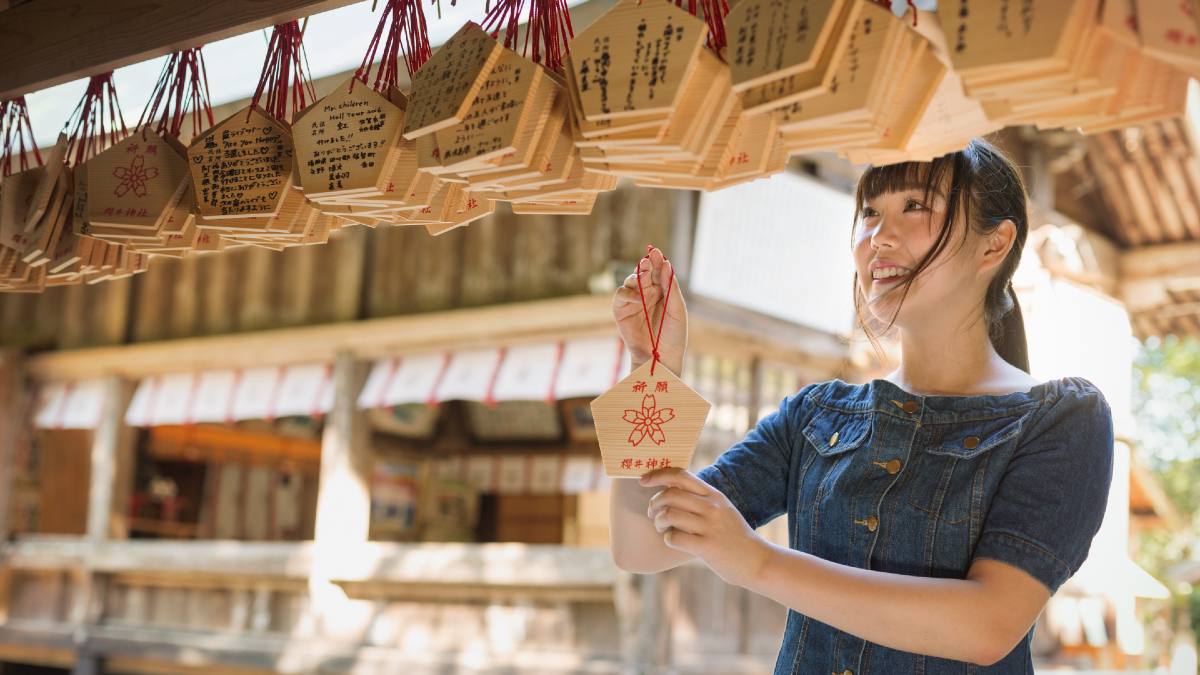
Both Buddhist temples and Shinto shrines are peaceful places to visit. Image: Getty
The best Edo-period towns and historical districts in Japan
During the Edo period (1603-1868), Japan was ruled by the Tokugawa shogunate and about 300 daimyo (feudal lords) who enforced strict social hierarchy and a isolationist foreign policy. This provided Japan with stability and economic growth after the chaotic Sengoku period. Arts and theatre flourished, producing new forms like kabuki, bunraku and ukiyo-e.
Walking through preserved Edo period districts allows travellers to experience life from centuries ago. The best places to explore Edo-period history include:
- Kawagoe, Saitama - often called Little Edo, this charming town has kept much of its Edo atmosphere. Visit the Warehouse District on Kurazukuri Street for the perfect photo opportunity of Edo-era storehouses, and listen for Toki no Kane (Bell of Time), a bell tower that still rings four times daily. Head to Candy Street for traditional Japanese lollies and visit Kitain Temple to see its 538 unique stone statues of Buddha.
- Edo Wonderland, Nikko - this theme park recreates an Edo period town, full of Edo style architecture and actors in period costume. Rent a costume, tour the shops and museums, play games and watch live theatre. Experiences include an archery range, shamisen workshop, ninja training hall and labyrinth, a haunted temple filled with Japanese spirits and demons, and several live-action shows.
- Ouchi-juku, Aizu-Wakamatsu - a post town from the Edo period famous for its handmade soba noodles and traditional thatched buildings on streets with running water on either side. Explore the Townscape Exhibition Hall to see Edo period tools, interiors and artefacts.
- Imaicho, Kashihara - Imaciho boasts Japan's largest preserved Edo townscape, with over 500 traditional houses and stores - many of which are open to the public or that still serve as working restaurants, shops and breweries. Visit during the Tea Procession in May to see traditional costumes and parades.
- Hagi Castle Town, Yamaguchi - Hagi's streets are so unchanged since the Edo period that it can still be explored with Edo-era maps! Formerly a residential area for samurai, the town still bustles with life and offers Hagi yaki pottery shops and local Hagi orange sweets.
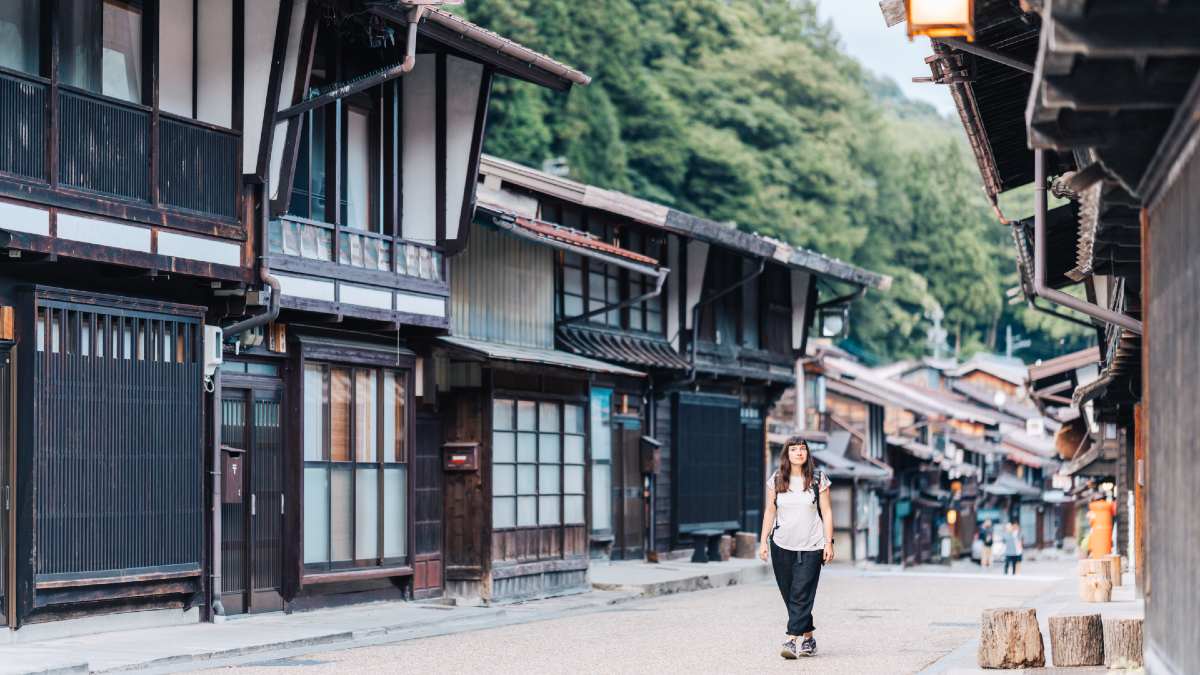
Exploring one of Japan's Edo-period towns is like stepping back in time. Image: Getty
Anime and manga attractions in Japan
Anime (animated film) and manga (comics and graphic novels) are cultural exports that have helped defined modern Japan. Popular series include Dragon Ball, Sailor Moon, Pokemon, One Piece or Naruto, while the most world-famous anime films like My Neighbour Totoro, Princess Mononoke, Howl's Moving Castle and Spirited Away are made by Studio Ghibli.
Where to explore anime and manga culture in Japan:
- Akihabara, Tokyo - this is Japan's hub for manga, anime, electronics and gaming stores - although Nakano Broadway is another great shopping mall in Tokyo focused on anime goods.
- Studio Ghibli Museum, Mitaka - just outside central Tokyo, visit the Studio Ghibli Museum to explore the work of Hayao Miyazaki in a magical setting, including animated exhibits and exclusive short films.
- International Manga Museum, Kyoto - houses hundreds of thousands of manga titles available for browsing at your leisure.
- Ghibli Park, Nagoya - unlike Studio Ghibli Museum, this is a theme park that recreates the atmospheric fantasy worlds from Ghibli movies.
- Pokemon Centre - found in major cities across Japan, Pokemon Centres sell Pokemon trading cards, toys, games, stationary and exclusives.
- Sanrio Puroland, Tokyo - indoor Hello Kitty theme park, complete with live shows and Sanrio products.
- AnimeJapan, Odaiba - take part in the world's largest anime exhibition at AnimeJapan (formerly the Tokyo International Anime Fair), held every year in late march at Odaiba's Tokyo Big Sight.
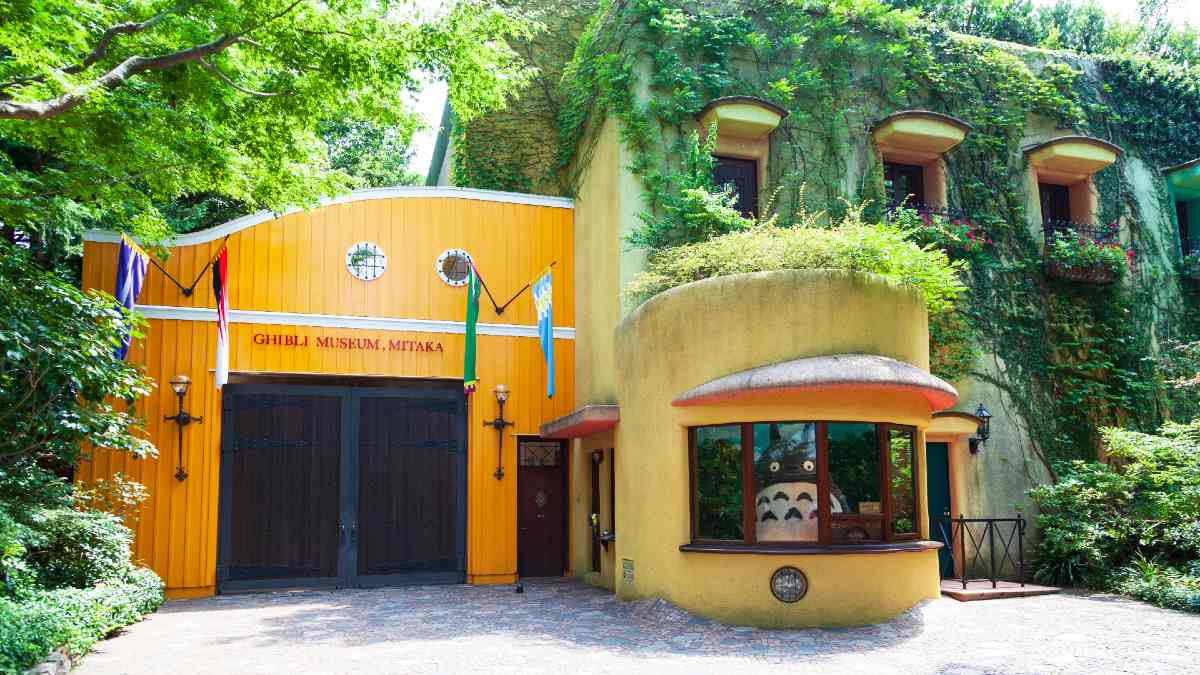
Tokyo's Ghibli Museum is a must-do for Miyazaki fans. Image: Getty
Gaming, arcades and Nintendo in Japan
Japan is a global capital of gaming culture, from retro arcades to cutting-edge VR experiences. Notable video game companies like Nintendo, Sega, Bandi Namco, Square Enix, Capcom and Sony all come from Japan. If you own a PlayStation or a Switch, you've probably played Super Mario, The Legend of Zelda, Resident Evil, Final Fantasy, Sonic the Hedgehog, Street Fighter, Animal Crossing, Tekken, Kingdom Hearts, Dark Souls and many other games from Japan.
Where to play and explore video games in Japan:
- Super Nintendo World (Universal Studios Japan), Osaka - inside Universal Studios Japan (where you'll also find Harry Potter World and characters like Spiderman), Super Nintendo World is a theme park featuring Nintendo rides, play experiences, character meet-ups, and even themed food outlets and merch stores. Yahoo!
- Nintendo Museum, Kyoto - discover the history of Nintendo's entertainment empire from Hanafuda to Nintendo Switch, with interactive exhibits, art galleries, play rooms - and of course, official merchandise for sale.
- Taito Station, Tokyo - Tokyo's Akihabara district is famous of anime, manga and gaming culture. At Taito Station, you'll find a multi-floor arcade with classic and modern games. Make sure to play Space Invaders, one of Taito's most influential games.
- SEGA Arcade, Tokyo - one of the largest arcades in Japan, located in Tokyo's busy Shinjuku district.
- Namja Town, Ikebukuro - indoor theme park by the creator of Pacman, with loads of arcade games, small rides and food stalls.
- Street Kart, Tokyo - ride street-legal go-karts around Tokyo and pretend you're in a Mario Kart game. You'll need an International Driving Permit (IDP) to participate.
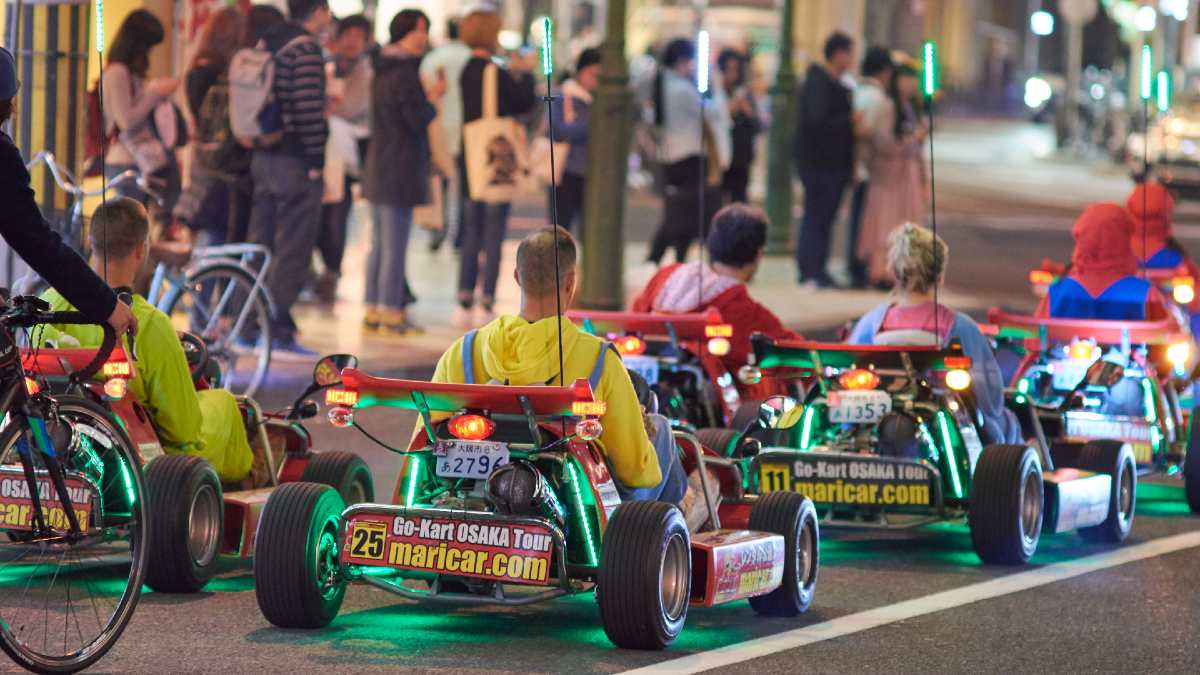
Tokyo offers Mario Kart-like experiences for guests. Image: Getty
Harajuku fashion and kawaii culture
Tokyo's Harajuku district is the birthplace of some of Japan's most iconic fashion subcultures. Harajuku fashion has become a diverse street style, from kawaii (cute) to punk, emphasising individuality and self-expression. Today, Harajuku remains a hub for young creatives and tourists seeking unique style experiences.
Top spots in Harajuku:
- Takeshita Dori - this popular street in Harajuku is an epicentre of trendy youth fashion and boutique shops.
- Omotesando - Tokyo's Champs-Élysées: a broad avenue with designer stores and upscale shopping blended with cafés and restaurants.
- LaForet Harajuku - seven floors of fashion boutiques and shops aimed at young, female shoppers.
- Kiddy Land - toy store heaven with the Sanrio and anime character goods popular with 'Harajuku girls'.
- Kawaii Monster Land - a neon amusement park full of rides, games and performances under Takeshita Street Square, reborn from the uber-popular Kawaii Monster Café that closed in 2021.
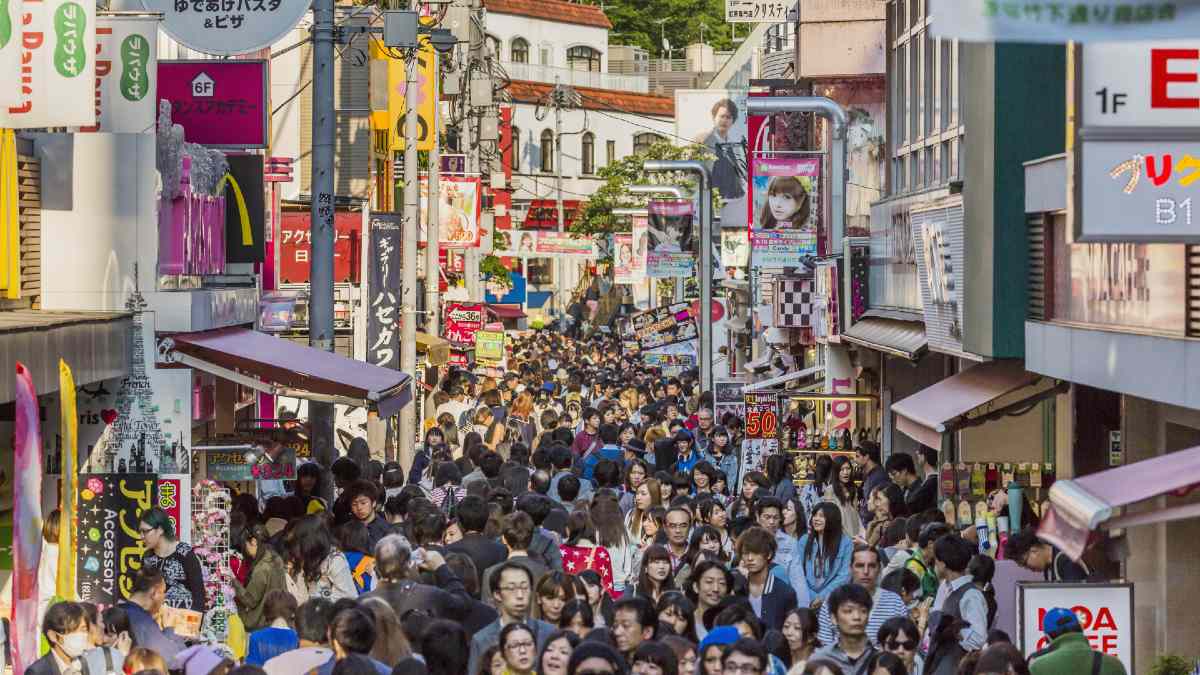
Takeshita Street in Tokyo's Harajuku district is full of boutique fashion. Image: Getty
J-pop and fan experiences in Japan
J-pop (Japanese pop) is a popular music genre with roots in traditional Japanese music, plus 1960s pop and rock music. Entering Japan's musical mainstream in the 1990s, J-pop has since become a modern cultural export, influencing fashion, dance and entertainment worldwide. If you've enjoyed AKB48, Arashi, YOASOBI, Ado, King Gnu, Radwips, SEKAI NO OWARI, Morning Musuem or BABYMETAL, then you're a J-pop fan!
Where fans can attend J-pop concerts and explore music-related attractions in Japan:
- AKB48 Theatre, Tokyo - home of the legendary idol group AKB48, nestled in Tokyo's busy and tech-forward Akihabara district. Catch a live performance almost every day!
- Tower Records Shibuya, Tokyo - mecca for J-Pop albums, merchandise, and events, just a three-minute walk from Shibuya Station.
- Tokyo Dome City, Tokyo - frequently hosts major concerts, including J-pop groups.
- Saitama Super Arena, Chūō-ku - hosts major J-Pop concerts and festivals.
- Tokyo Idol Festival, Odaiba - annual music festival celebrating idol groups, with many live performances by J-pop artists.
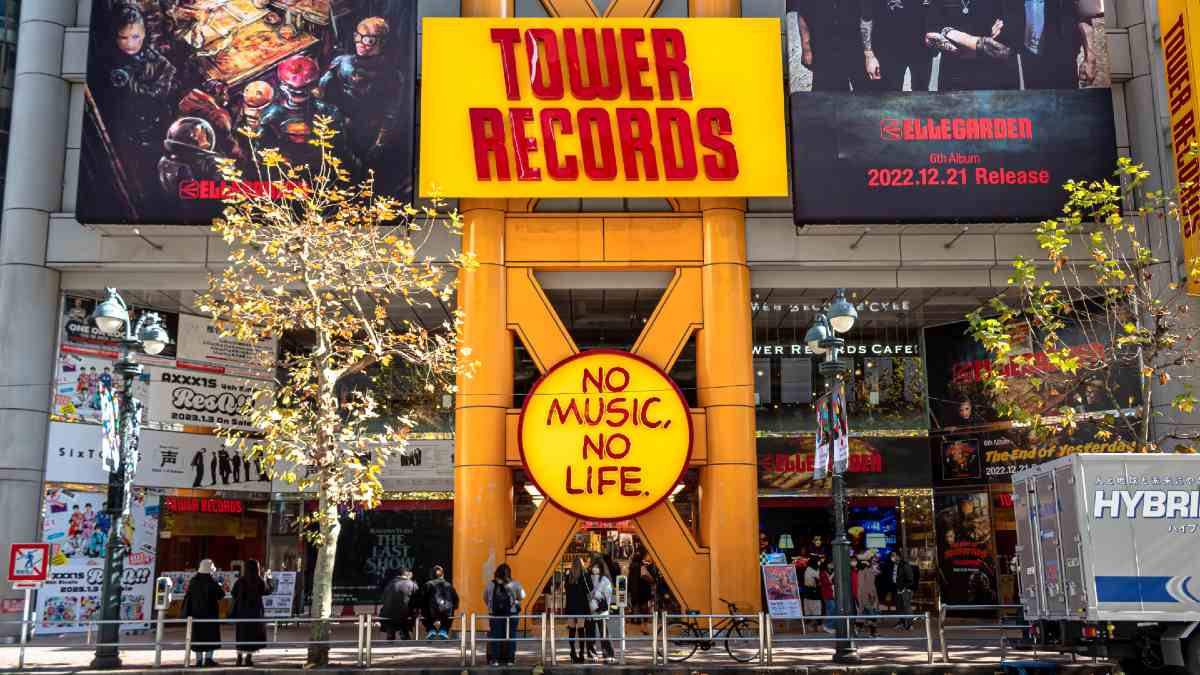
Tower Records in Tokyo is a mecca for J-pop merch and events. Image: Getty
Best cherry blossom (sakura) viewing spots in Japan
The cherry blossom (sakura) is perhaps the most famous symbol of Japan. The tradition of hanami (flower viewing) dates back over a thousand years, when emperors and aristocrats would gather under the blossoms to appreciate their fleeting beauty. Today, hanami is a national pastime each spring, when families and friends picnic beneath pink canopies.
Top places to see sakura in Japan:
- Ueno Park, Tokyo - over a thousand blooming cherry trees and lively hanami celebrations, with geisha performances and lanterns lighting up the cherry blossoms by night.
- Hirosaki Castle Park, Aomori - a cherry blossom festival is held here in late April each year, with picnic areas, rental rowing boats, moats filled with fallen cherry blossom petals, and nighttime illuminations.
- Mount Yoshino, Nara - more than 30,000 cherry trees blanket this mountainside in spring, with a trail guiding visitors up the mountain to different views.
- Takada Castle Park, Joetsu - see pretty pink cherry blossoms lit by soft lanterns, reflecting the moat below Takada Castle's turrets.
- Matsukawa River, Toyama - board a boat at Matsukawa Tea House and cruise through a natural tunnel of 500 white cherry blossom trees.
More: Where to see cherry blossoms in Melbourne and regional Victoria this spring
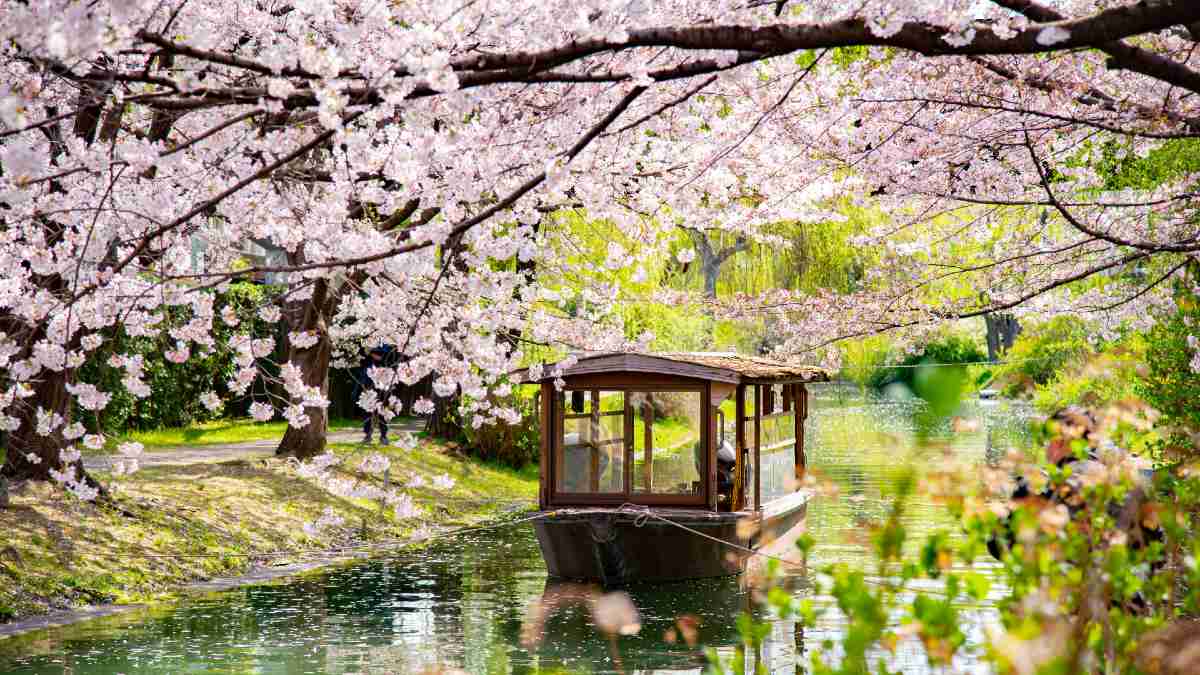
Consider travelling to Japan in time for the cherry blossoms. Image: Getty
Where to see autumn leaves (koyo) in Japan
Koyo (autumn leaf viewing) has been celebrated in Japan for centuries, with temples and gardens designed to showcase seasonal beauty. The Japanese maple, with its vivid crimson leaves, is particularly beloved.
Best places to see autumn leaves in Japan:
- Naruko Gorge, Naruko - from mid October to early November, Naruko Gorge coats the mountains in fiery colours. From Narukokyo Resthouse, walk to the Ofukazawa Bridge viewing platform for some of the best views.
- Eikando Temple, Kyoto - also known an Zenrinji Temple, Eikando is one of the most popular places in Kyoto to view autumn leaves. Explore pagodas, temple halls, ponds and gardens in the second half of November for the best koyo views.
- Daisetsuzan National Park, Hokkaido - this is the first place in Japan to see autumn colours each year, with visitors able to explore a vast wilderness area.
- Korankei Gorge, Aichi - attend the annual Korankei Maple Festival in November to see over 4,000 maple trees planted by 17th-century monks burst into colour. Enjoy festival food, traditional performances like taiko drumming, and illuminated trees from sunset.
- Ryuzu Waterfall, Nikko - flanked by red and yellow trees in autumn; best in early October.
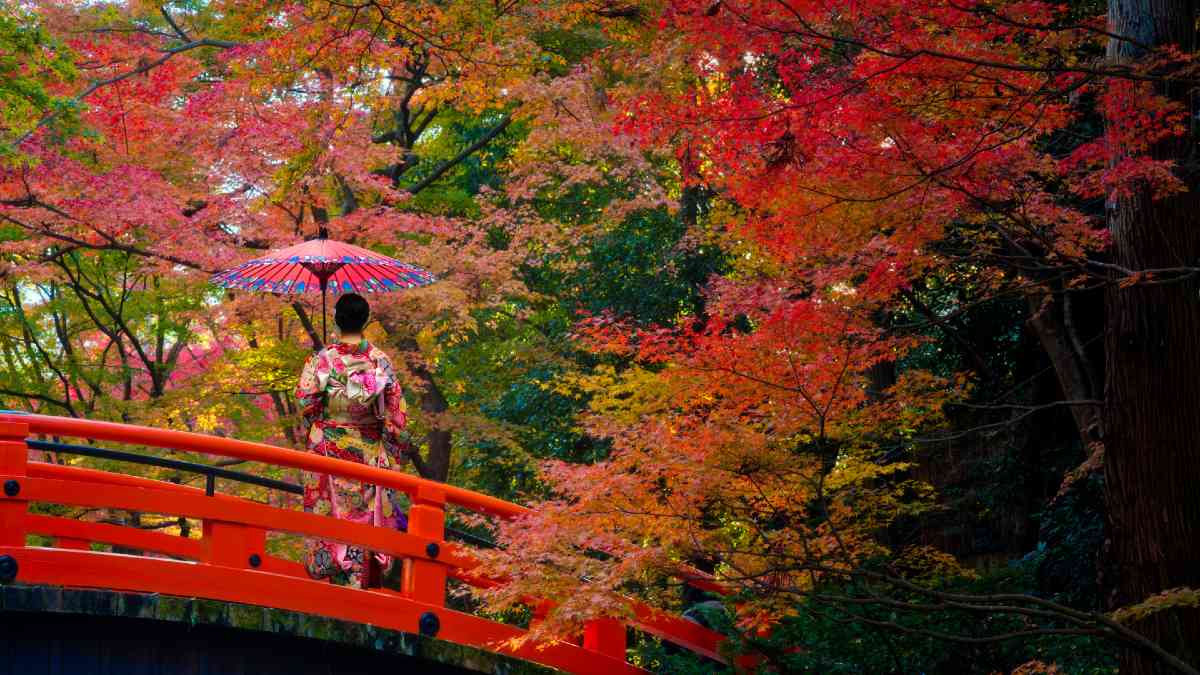
Autumn is a beautiful time to visit Japan. Image: Getty
Visiting Mount Fuji
Mount Fuji is Japan's tallest mountain and its most iconic natural landmark. Long considered a sacred place (Mount Fuji is one of Japan's Three Holy Mountains), it's frequently depicted in art, photography and film.
Where to admire Mount Fuji in Japan:
- Mount Fuji World Heritage Centre, Fujinomiya - this museum's top floor hosts an observation hall with an open-air deck so visitors can enjoy spectacular views of Mt Fuji. Inside, exhibitions highlight Mt Fuji's history, geography and cultural significance.
- Fuji Five Lakes (Fujigoko), Yamanashi - a lake resort area around the Kawaguchiko, Saiko, Yamanakako, Shojiko and Motosuko lakes at the northern base of Mt Fuji. A great place to view Mt Fuji from a close distance, the area also offers hiking, camping, fishing, hot springs and museums.
- Hakone, Kanagawa - onsen town with views of Mt Fuji across Lake Ashinoko.
- Senjojiki Cirque, Kiso Alps - enjoy panoramic views of Mt Fuji and the Southern Alps thanks to the Komagatake Ropeway.
- Bunkyo Civic Centre, Tokyo - on clear days, Mount Fuji can be seen from this observation deck, looming behind the Shinjuku district skyscrapers.
When you take out a travel insurance policy, always check if the sports and activities you wish to participate are covered. You may need additional cover, or those activities may not be covered under any policies. For example, Mount Fuji's height is 3,776m above sea level, and RACV Travel Insurance does not cover trekking or hiking over 3,000 metres above sea level. See the Product Disclosure Statement (pages 24-26) for more details.
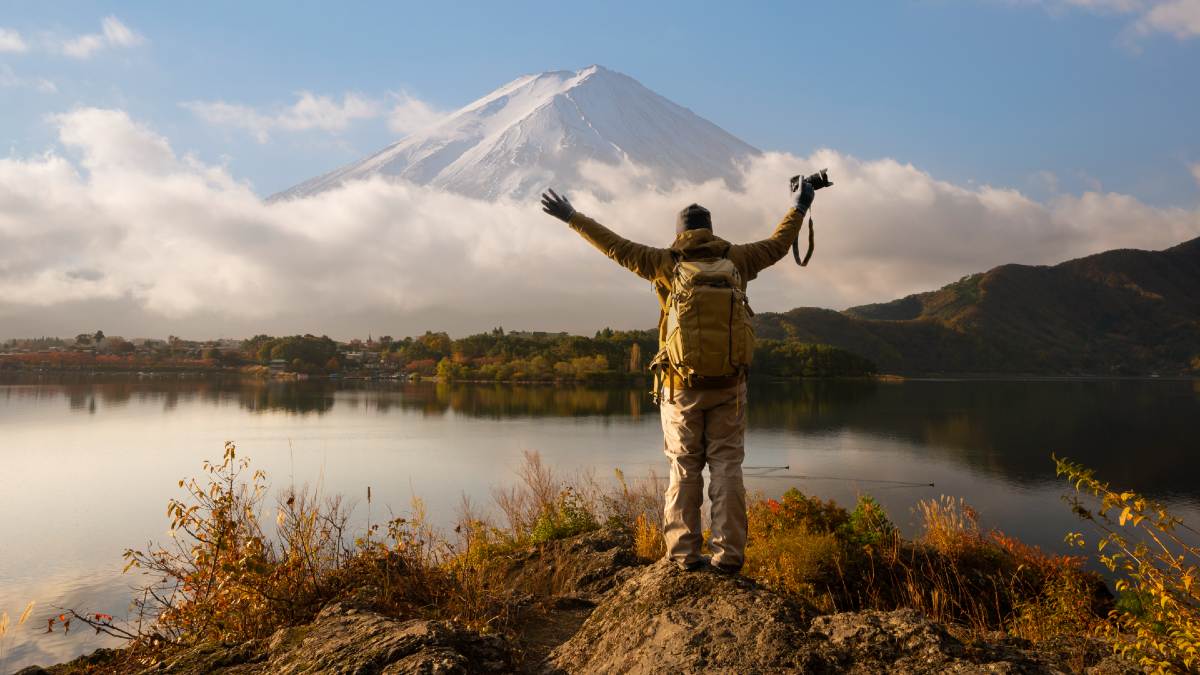
Mt Fuji is a must-visit for many tourists to Japan. Image: Getty
Japan's best national parks and hiking trails
Japan has 34 national parks, each highlighting the country's rich biodiversity and cultural heritage. Many national parks combine natural wonders with historic shrines and villages.
Must-visit national parks in Japan:
- Fuji-Hakone-Izu National Park - this large national park is split into four areas: Mount Fuji, Hakone, Izu Peninsula and Izu Islands. Here you'll find everything from volcanic valleys (like Owakudani) to caldera lakes (like Lake Ashinoko) and traditional teahouses (like Amasake Chaya).
- Nikko National Park, Nikko - home to UNESCO shrines and waterfalls, plus an ancient tradition of mountain worship: the Nikko Sanzan (Mt Nantai, Mt Nyoho and Mt Taro) dominate the area.
- Shiretoko National Park, Hokkaido - a remote wilderness with brown bears, orcas and drift ice.
- Yakushima National Park, Kagoshima - lush coastlines and ancient cedar forests that inspired Studio Ghibli’s Princess Mononoke film.
- Aso-Kuju National Park, Kyushu - hike through forests (try Narukogawa Keikoku), highlands (the Kokonoe Yume Otsurihashi Bridge is Japan's highest suspension bridge) and wetlands (Tadewara Marsh is a don't-miss spot), with stops at local hot springs like Kurokawa Onsen.
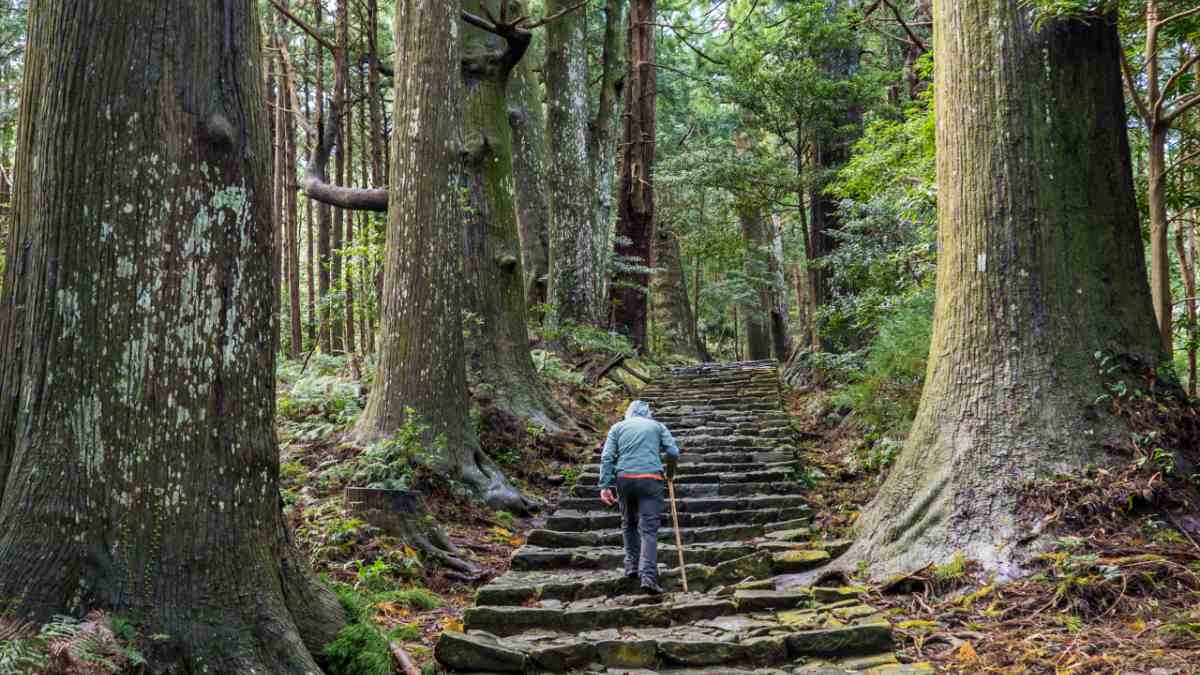
The Kumano Kodo in Japan's Kii Peninsula is a beautiful hike. Image: Getty
Top ski and snowboard resorts in Japan
Japan is one of the world's best ski and snowboard destinations, thanks to its abundant powdery snow and relaxing hot springs. With over 500 ski resorts across Japan, there are many places to enjoy the snow. The best snow conditions are generally found in Hokkaido, Tohuku, Niigata and Nagano.
Top ski destinations:
- Niseko, Hokkaido - world-famous powder snow and a lively après-ski scene.
- Hakuba, Nagano - good snow and several big ski resorts, with some Olympic facilities still in use from hosting the 1998 Winter Olympics.
- Nozawa Onsen, Nagano - a traditional hot spring town, with ski runs for every level.
- Shiga Kogen, Nagano - Japan's biggest ski area, with nearly 50 lifts, gondolas and ropeways.
- Furano, Hokkaido - a family-friendly ski resort with scenic views.

Japan is world-famous for its great skiing and snowboarding season. Image: Getty
Best onsen (hot spring) towns and resorts in Japan
Onsen (hot springs) are one of Japan's most treasured traditions, blending wellness and culture. Found throughout the country, onsen towns often feature picturesque ryokan (traditional inns), open-air baths and scenic natural backdrops.
Top onsen towns to visit in Japan:
- Beppu, Oita (Kyushu) - western Japan's largest hot spring resort, with eight major hot spring areas. It's famous for the Jikogu (Hells of Beppu): cobalt blue to blood-red hot water, steam and gas pools.
- Kusatsu Onsen, Gunma - Kusatsu's waters are so good for the skin that several shoguns had it transported in barrels to their castle in Edo (Tokyo). After bathing, try onsen tamago (eggs boiled in the hot springs), watch the yumomi performance at Netsunoyu Hall to see traditional hot spring coolers at work, and visit the Yubatake hot water fields in the centre of town.
- Noboribetsu Onsen, Hokkaido - renowned for mineral-rich waters sourced from Jigokudani (Hell Valley), which creates nine types of bathing water.
- Shibu Onsen, Nagano - it's considered good luck to bathe in all nine public baths, which you can use for free when you stay at one of the village inns. Plus, it's just a 10-minute bus ride to Snow Monkey Park, where you can watch cute monkeys enjoying similar hot springs!
- Higashiyama Onsen, Aizu-Wakamatsu - elegant, historic bathhouses with both private and public hot springs, once visited by daimyo and samurai.
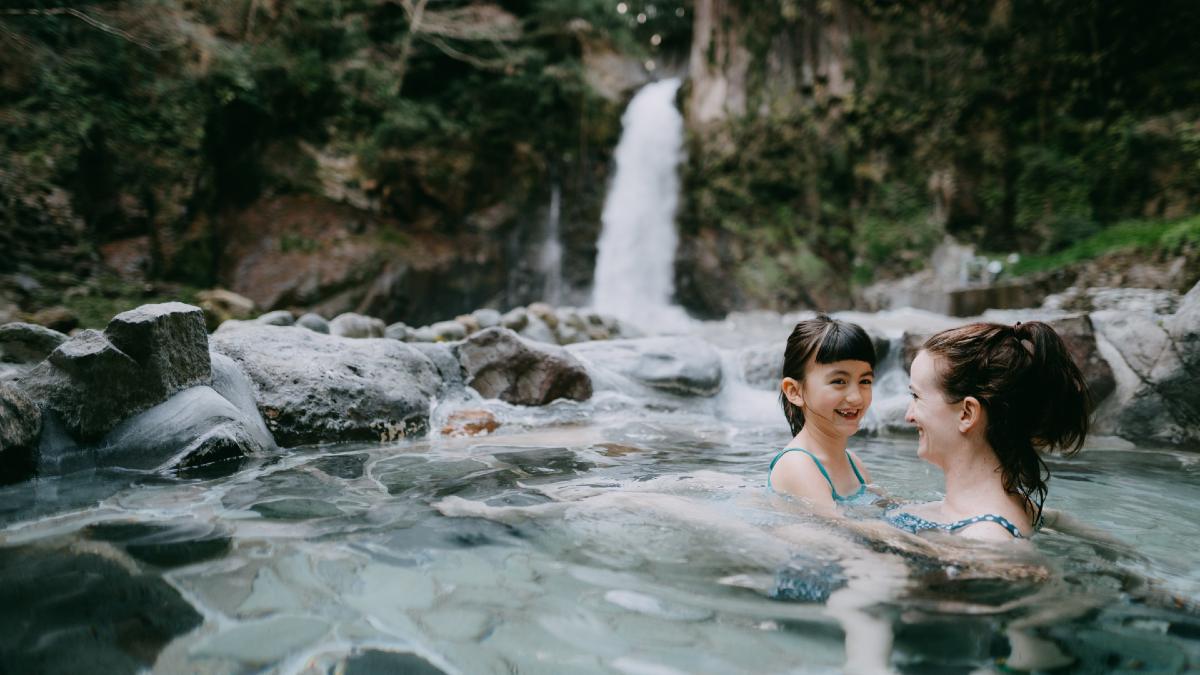
Relaxing in an onsen is the perfect wellness activity. Image: Getty
Temple stays, meditation and forest bathing
For those seeking peace, Japan offers temple stays (shukubō), Zen meditation sessions, and shinrin-yoku (forest bathing): the practice of immersing oneself in nature to restore wellbeing. These experiences allow travellers to slow down, reconnect with nature and better understand Japan's deep spiritual traditions.
Where to try temple stays and forest bathing in Japan:
- Kōyasan, Wakayama - the centre of Shingon Buddhism, where visitors can stay overnight in temple lodgings, join monks for meditation and enjoy vegetarian shōjin ryōri meals.
- Zenkoji Temple, Nagano - offers overnight temple stays in a 1,400-year-old Buddhist complex, with yoga, tea, zazen and sutra transcription experiences.
- Kakurinbo, Yamanashi - stay in a stately wooden shukubo with an ornate Japanese garden and vegetarian cuisine. There are many cultural experiences on offer, from Buddhist statuette carving to miso making, calligraphy, morning yoga, tea ceremony, shodaigyo chanting and more.
- Takaosan Yakuoin Temple, Greater Tokyo - known for shugendo (mountain asceticism), this temple invites guests to join meditative sessions such a takigyo.
- Fukiji Temple, Kunisaki Peninsula - Zazen seated meditation is popular at Fukiji Temple thanks to its peaceful woodland surroundings.
- Yakushima Island, Kagoshima - a UNESCO World Heritage site, ideal for forest bathing among thousand-year-old cedar trees.
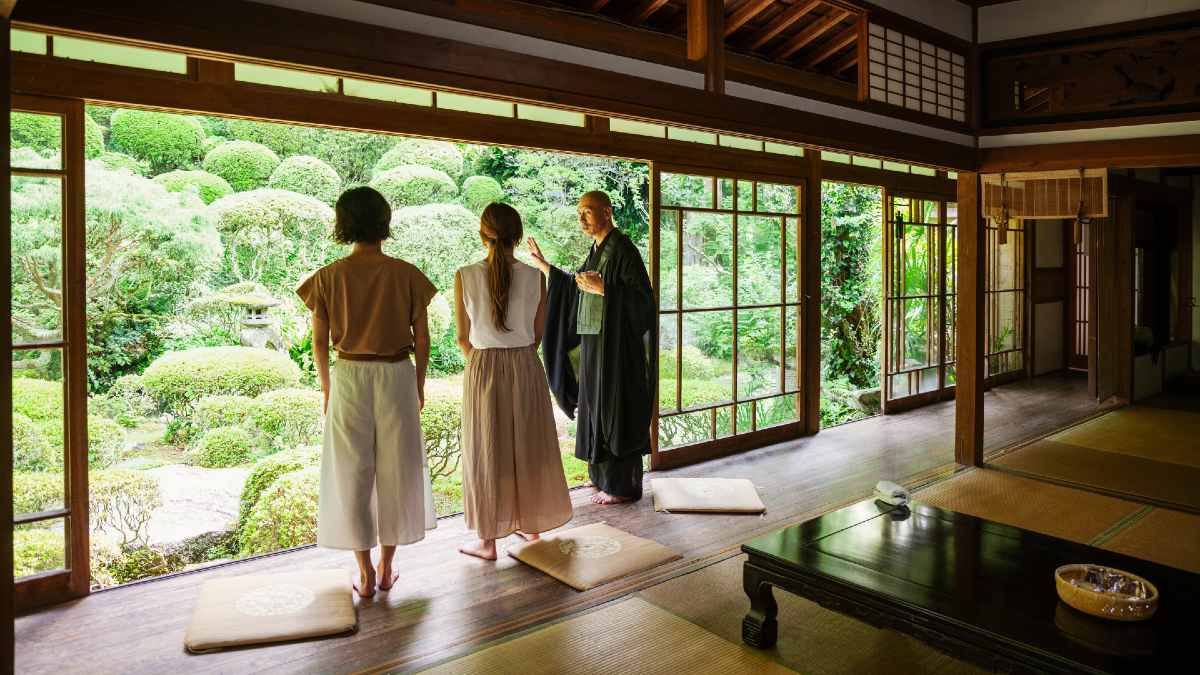
A ryokan stay might include meditation sessions with resident monks. Image: Getty
Beautiful Japanese gardens and tea houses
Japanese gardens embody harmony, balance and tranquillity, often designed for contemplation rather than strolling. Many feature tea houses where the centuries-old art of the Japanese tea ceremony is practised. Experiencing one of these gardens allows visitors to see the artistry of landscaping intertwined with spiritual values.
Where to enjoy Japanese gardens and tea houses:
- Kenrokuen Garden, Kanazawa - considered one of Japan's Three Great Gardens, famous for its seasonal beauty and tea houses.
- Korakuen Garden, Okayama - another of the Three Great Gardens, blending ponds, walking paths and traditional structures.
- Katsura Imperial Villa, Kyoto - a masterpiece of Japanese garden design, with elegant tea houses and carefully crafted views.
- Shinjuku Gyoen, Tokyo - a large urban park featuring Japanese, English and French-style gardens, plus tea houses for ceremonies.
- Ritsurin Garden, Takamatsu - a sprawling landscaped garden where visitors can enjoy tea by the pond in a historic teahouse.
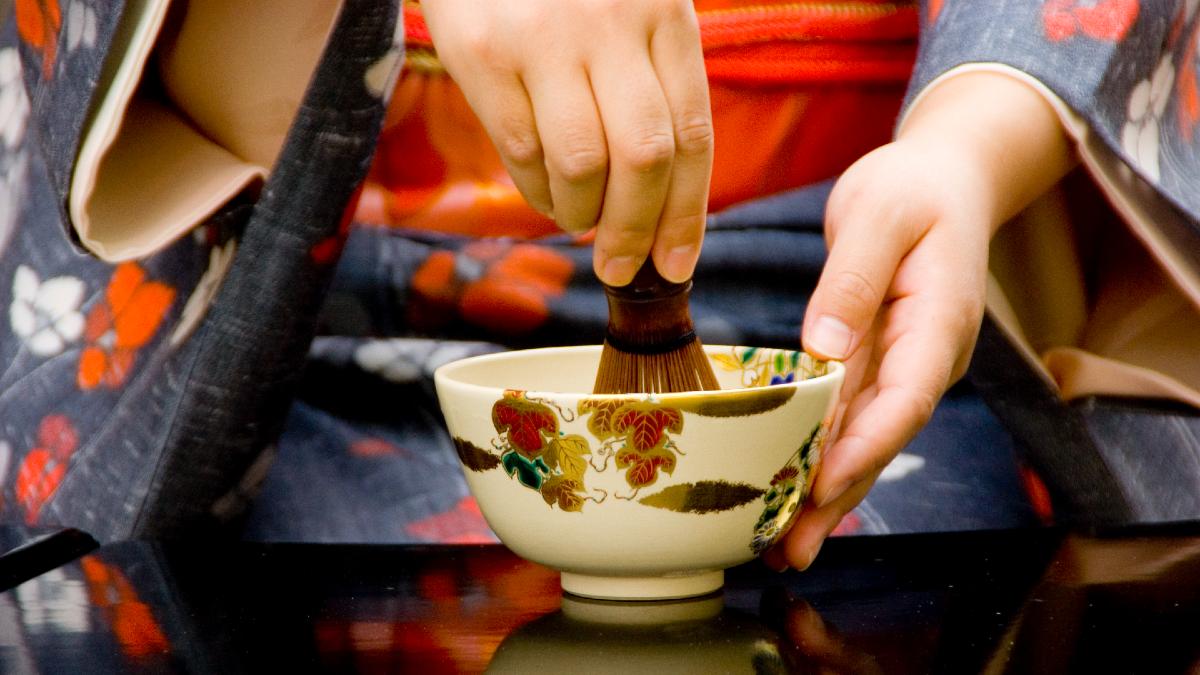
In Japan, the tea ceremony is very poignant and exact. Image: Getty
Regional Japanese specialities you must try
Designated as UNESCO Intangible Cultural Heritage, washoku (traditional Japanese cuisine) emphasises seasonal ingredients, balance and presentation.
Japanese cuisine is deeply regional, with each prefecture proud of its own specialties. Sampling local flavours is one of the best ways to understand Japan's cultural and geographic variety.
Regional must-try dishes in Japan include:
- Hiroshima Okonomiyaki (Hiroshima) - layered savoury pancake filled with noodles, seafood and cabbage, cooked on a hotplate.
- Hakata Ramen (Fukuoka, Kyushu) - rich pork-bone broth ramen, famous for its creamy flavour and thin noodles.
- Hida Beef (Takayama, Gifu) - a rival to Kobe beef, prized for its marbling and melt-in-the-mouth tenderness.
- Seafood Donburi (Hokkaido) - bowls of rice topped with ultra-fresh seafood such as uni (sea urchin), crab and salmon roe.
- Kyo-kaiseki (Kyoto) - a refined, multi-course dining experience showcasing seasonal ingredients and exquisite presentation.
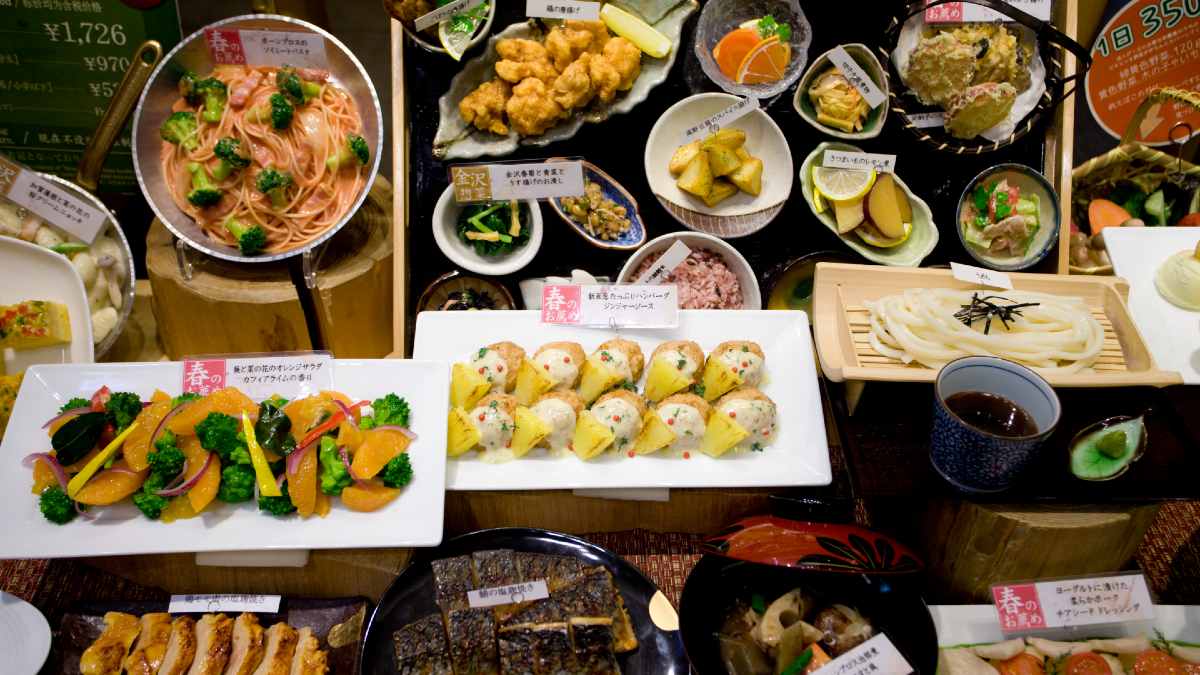
Many Japanese restaurants display plastic examples of their dishes. Image: Getty
Street food markets in Japan
Japanese street food is vibrant, affordable and deeply tied to regional identity. From Osaka's takoyaki to Hiroshima's okonomiyaki, markets and food streets are where travellers can taste authentic local flavours.
Best places to sample Japanese street food:
- Nishiki Market, Kyoto - known as Kyoto's Kitchen and offering skewered seafood, pickles, sweets and matcha treats.
- Kuromon Ichiba Market, Osaka - a bustling food hub nicknamed Osaka's Kitchen, with takoyaki, grilled crab and wagyu beef skewers.
- Ameya-Yokocho (Ameyoko), Tokyo - a post-war black market turned lively shopping street in Tokyo's Taito district, now home to affordable snacks and street eats.
- Omoide Yokocho, Tokyo - a narrow laneway in Tokyo's Shinjuku district, packed with yakitori and izakaya stalls, perfect for an atmospheric night out.
- Omicho Market, Kanazawa - Kanazawa's Kitchen since the Edo period; famous for fresh seafood, especially crab and sashimi bowls from the Sea of Japan.
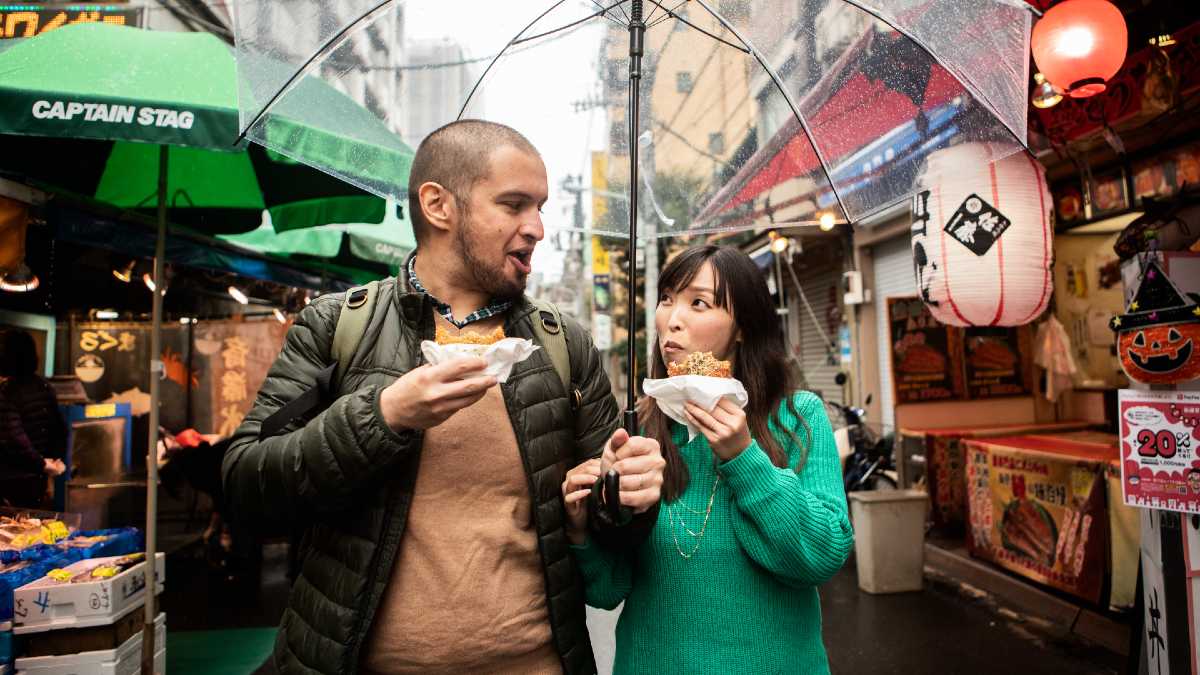
Japanese street food is delicious, but try to sit down to eat! Image: Getty
Sake breweries and tasting tours
Sake (nihonshu) is Japan's iconic rice wine, has been brewed for over a thousand years and is deeply tied to festivals, rituals and daily life. Visiting breweries provides insight into traditional methods, regional variations, and tasting experiences that highlight Japan's artisanal approach to food and drink.
Where to enjoy sake tours and tastings:
- Nada Sake District, Kobe - Japan's most famous sake region, home to major breweries offering guided tours, tastings and exhibitions.
- Fushimi Sake District, Kyoto - historic sake-producing area, with nearly 40 breweries along scenic canals. Some are open the public, with shops, restaurants, museums and exclusive brews.
- Saijo, Hiroshima - explore the eight Saijo breweries on Sakagura-dori: Sake Brewery Street.
- Niigata Prefecture - known for high-quality rice and water, Niigata produces some of the country's smoothest sake varieties. At JR Niigata Station, there are over a hundred vending machines with sake from all over the prefecture.
- Takayama, Gifu - high-quality sake breweries near the Japanese Alps, with rare brews.
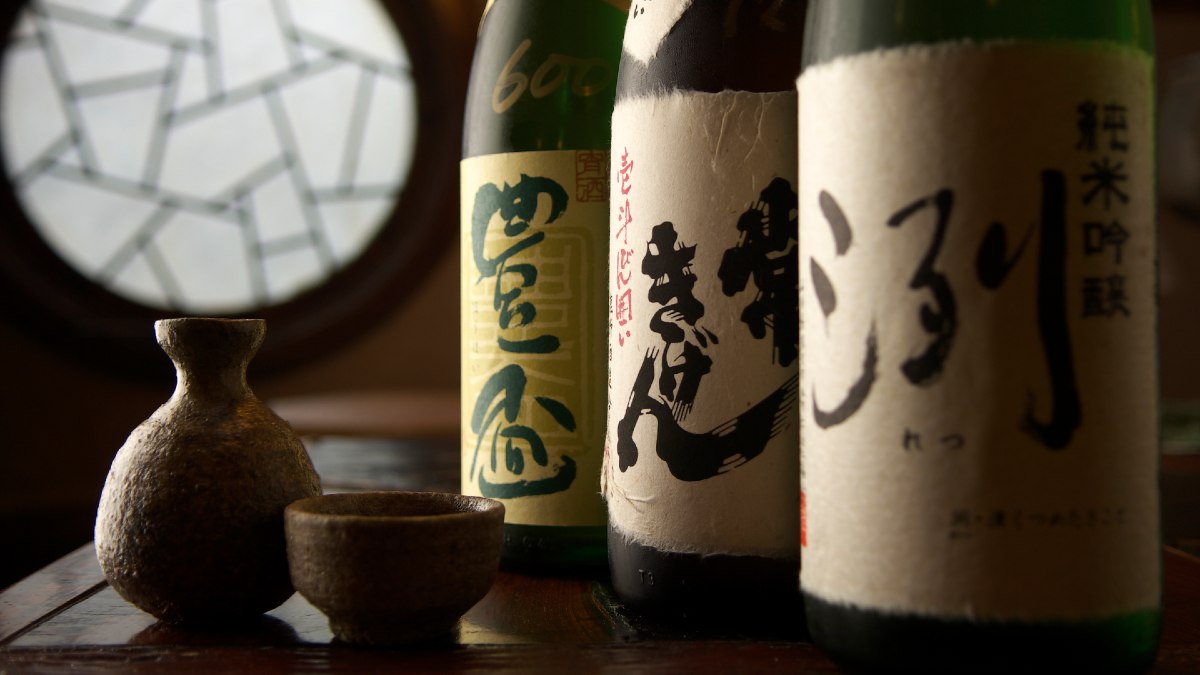
Sake, Japan's iconic rice wine, is celebrated worldwide. Image: Getty
Themed cafes and restaurants in Japan
Japan has perfected the art of the themed café: whimsical, eccentric and often unlike anything else in the world. These spots blend dining with entertainment, appealing to pop culture fans and curious travellers alike.
Not-to-miss themed cafés, bars and restaurants in Japan:
- Maidreamin, Tokyo - one of Akihabara's most famous maid cafés, where waitresses in maid costumes serve food with theatrical flair in kawaii rooms filled with soft pop music.
- Samurai Restaurant Time, Tokyo - a neon-lit spectacle with samurai, robots and dancers performing nightly entertainment shows as you dine on traditional Japanese cuisine.
- Harry Hedgehog Café, Tokyo - one of Japan's popular animal cafés, where guests can interact with hedgehogs and other small animals in a quirky setting. Venture to Tokyo's Akihabara district for more animal cafés featuring owls, cats, bunnies, mini pigs and more.
- Vampire Cafe, Tokyo - enter a vampire mansion brought to life, with creative cuisine and cocktails in a restaurant full of spooky décor.
- Detective Bar Progress, Tokyo - a crime-fighting themed cafe where the staff are real private investigators by day.

Cat cafes have exploded in popularity around the world. Image: Getty
Seasonal matsuri and cultural events in Japan
Matsuri (festivals) are an essential part of Japanese life, often tied to seasonal changes or Shinto traditions. They showcase elaborate floats, fireworks, costumes and food.
Unmissable Japanese festivals:
- Gion Matsuri, Kyoto (July) - Japan's most famous festival, held over the entire month of July around Yasaka Shrine. It dates all the way back to 869 as a ceremony to appease the gods. Don't miss Yamaboko Junko, the grand procession of floats!
- Awa Odori, Tokushima (August) - energetic dance festival (literally, Fool's Dance), with thousands of performers from amateurs to professionals in colourful uniforms.
- Kanda Matsuri, Tokyo (May) - celebrated at Kanda-jinja Shrine every two years, you'll see floats, portable shrines, parades of musicians and priests on horses and more.
- Tsuwano Yabusame Festival, Shimane (April) - yabusame is Japanese mounted archery, performed as a martial art and as entertainment for Shinto deities. Tsuwano hosts Japan's only surviving single-purpose yabusame ground, which is used when the cherry blossoms peak.
- Yokote Snow Festival, Akita (February) - a 450-year-old festival that invites guests into kamakura igloos to honour the water gods with offerings of sake and rice cakes. The igloos light up at night, providing a stunning and romantic atmosphere.
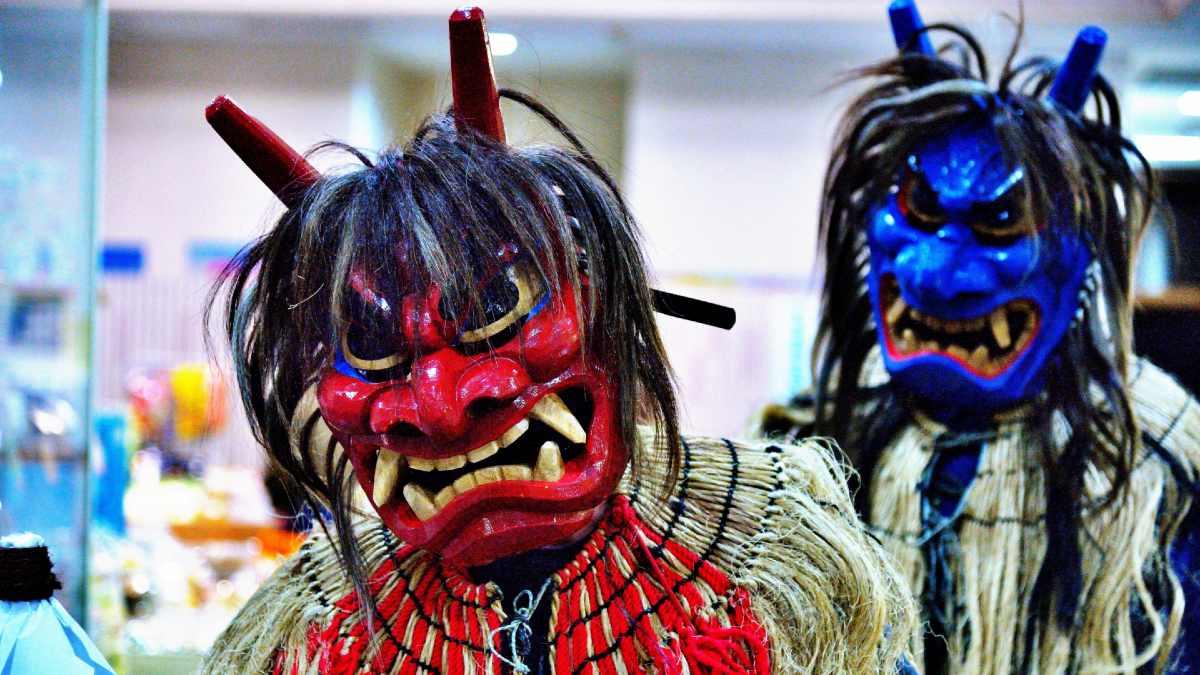
Many Japanese festivals feature creatures from folklore. Image: Getty
Best hanabi fireworks festivals in Japan
Fireworks, or hanabi (literally 'fire flowers'), have been a beloved summer tradition in Japan for centuries. More than just displays of light, these festivals are community events where locals wear yukata, enjoy street food and celebrate together under the night sky. Many shows are enormous in scale, drawing crowds of tens of thousands.
Top fireworks festivals to see in Japan:
- Sumidagawa Fireworks Festival, Tokyo - dating back to the 18th century, this riverside event is one of Japan's most famous, lighting up the skies over Asakusa.
- Nagaoka Fireworks Festival, Niigata - a two-day spectacle with giant phoenix fireworks symbolising peace and recovery.
- Lake Biwa Fireworks Festival, Shiga - staged over Japan's largest freshwater lake, creating beautiful reflections across the water.
- Omagari Fireworks Competition, Akita - a prestigious national contest where pyrotechnicians compete with creative displays.
- Miyajima Water Fireworks Festival, Hiroshima - held against the iconic floating torii gate of Itsukushima Shrine, blending nature and culture.
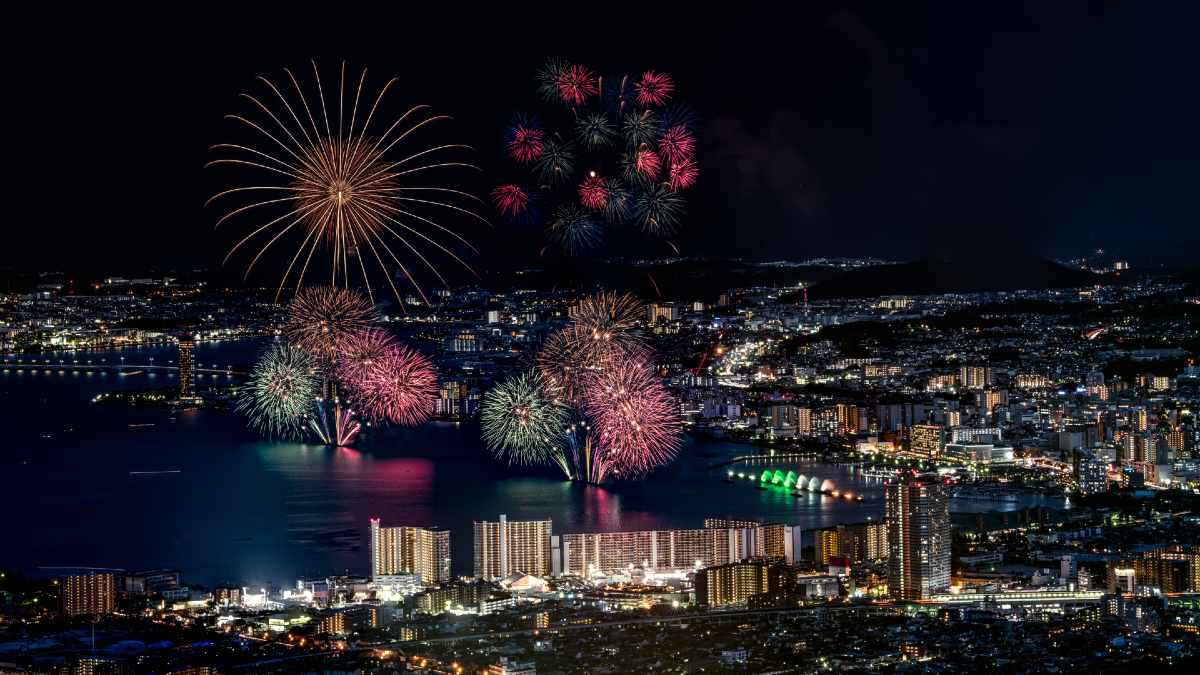
Lake Biwa boasts an incredible hanabi fireworks festival. Image: Getty
Traditional Japanese theatre: Kabuki, Noh and Bunraku
Japan boasts three major forms of theatre. Kabuki is a blend of dramatic acting, dancing and music, with beautiful and elaborate costumes. Noh is an ancient masked theatre form with minimalist movements and spiritual narratives. Bunraku is historical puppet theatre that brings old tales to life.
Where to experience traditional theatre in Japan:
- Kabukiza Theatre, Tokyo - the grand home of Kabuki theatre in Tokyo, located in the Ginza district and offering daily performances.
- Minamiza Theatre, Kyoto - the oldest Kabuki theatre in Japan, founded in the 17th century.
- National Noh Theatre, Tokyo - hosts Noh and Kyōgen (comic interludes) with subtitles and cultural explanations in Tokyo's trendy Harajuku district.
- National Bunraku Theatre, Osaka - the best place to see Bunraku puppet theatre, a UNESCO-listed art form.
- Kanamaruza, Kotohira - Japan's oldest surviving Kabuki playhouse, where you can tour the stage machinery and occasionally see performances.
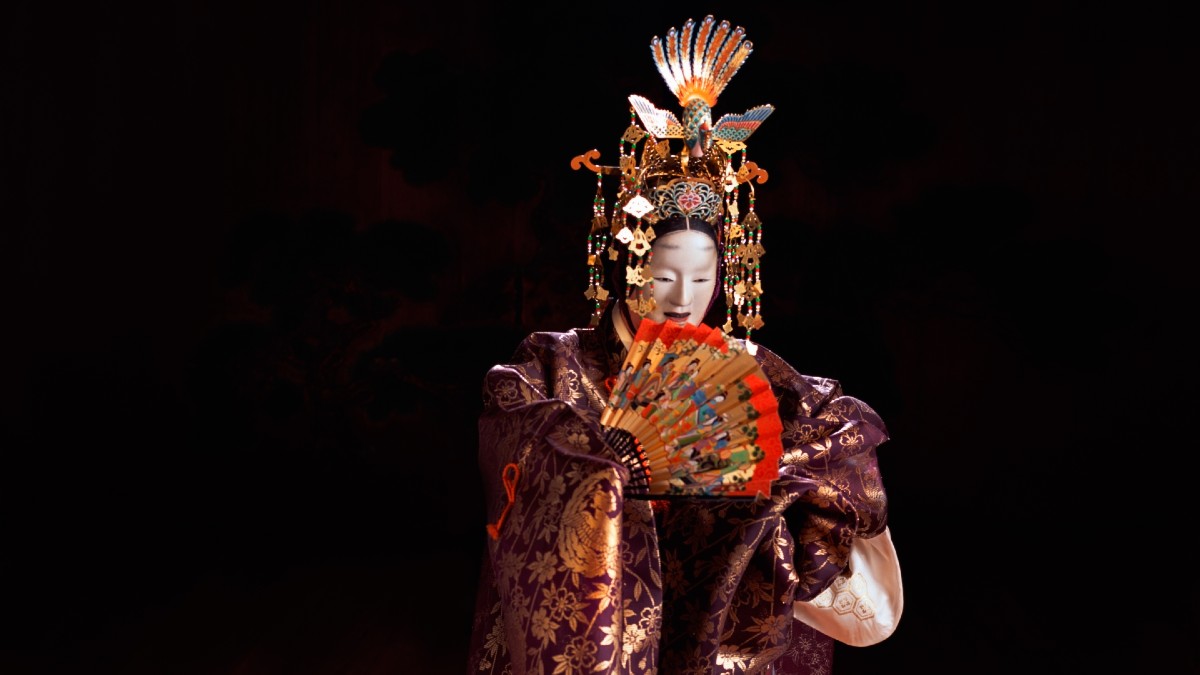
Noh theatre uses stylised characters, like the Tennyo (celestial maiden) Hagoromo. Image: Getty
Essential Japan travel tips
Japanese etiquette for visitors
Politeness and respect is key in Japan. Some key etiquette rules to remember when visiting Japan include:
- bowing your head when greeting or thanking someone.
- removing your shoes before entering homes, temples, shrines, ryokan-style accommodations or any other area with 'remove shoes' signs. You will usually be given slippers for use indoors. Remove the slippers before walking on any tatami mats.
- refraining from speaking on your phone, or having loud conversions, on public transport.
- handling money with both hands, or placing it in trays for the exchange when provided.
- not attempting to tip: this is often considered rude rather than a compliment.
- sitting down to eat or drink rather than walking and consuming.
- carrying your rubbish back to your hotel room (there are not many public bins except at train stations).
- not crossing your chopsticks or using them to 'hand' a piece of food to someone else's chopsticks.
- trying to eat all your food at restaurants; leaving leftovers or asking for a 'doggy bag' is frowned upon.
- only smoking in designated smoking areas.
Useful Japanese phrases for tourists
Many Japanese people speak English, but it's polite to learn some key phrases in Japanese when travelling there. Some of the best words and phrases to learn are:
- konnichiwa - hello
- sumimasen - sorry, excuse me
- arigatou gozaimasu - thank you
- kudasai - please
- itadakimasu - thank you for the food (before eating a meal)
- gochisosama-deshita - thank you for the food (after finishing a meal)
- wakarimasen - I don't understand.
Visa, money and transport tips for Japan
Do Australians need a visa for Japan?
Australians do not need a visa to travel Japan for up to 90 days, as long as you don't work or study there.
Is Japan expensive to visit?
Japan can be affordable with careful planning. There are many hostels, and convenience stores offer cheap meals, often with ATMs and Wi-Fi. Rail travel is costly but can be offset with passes.
Should I use cash or card in Japan?
Cash is still king in Japan. Smaller vendors and rural areas usually require you to use cash. Large cities and establishments usually allow you to use a debit or credit card, although you should check with your bank whether your card will work in Japan.
Keep in mind that many Japanese ATMs don't accept foreign cards, and many are out of service overnight. 7-Eleven convenience stores are your best bet for a 24/7 ATM that accepts foreign cards; Japan Post ATMs are also good. Withdraw yen in advance and keep small denominations handy, as many ticket and vending machines won't accept larger cash and coin amounts.
What to pack for your Japan trip
When packing for your Japan trip, along with your usual necessities, make sure to include:
- your passport
- a visa (if visiting for longer than 90 days)
- your travel insurance details
- yen (Japanese cash)
- an anti-theft bag
- an International Driving Permit (IDP) if you plan to drive or hire a car or have a Mario Kart-style go-karting experience. IDPs are issued by the Australian Automobile Association (AAA) through RACV, which is the only authorised seller of IDPs in Victoria. To get one, apply online or go to an RACV retail store.
- a Japan travel adapter to charge your smartphone
- shoes that are comfortable for walking and easy to remove when switching to indoor slippers
- a reusable shopping bag
- layers for spring and autumn
- a warm coat for winter.
The information provided is general advice only. Before making any decisions please consider your own circumstances and the Product Disclosure Statement and Target Market Determinations. For copies, visit racv.com.au. Royal Automobile Club of Victoria (RACV) Ltd AR 001243563 is an authorised representative of the issuer and receives commission for each policy sold or renewed. RACV Travel Insurance issued by Tokio Marine & Nichido Fire Insurance Co., Ltd ABN 80 000 438 291 AFSL 246 548. Terms & conditions apply, refer to the PDS.


